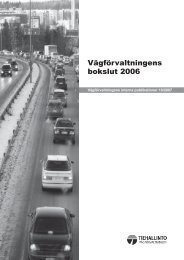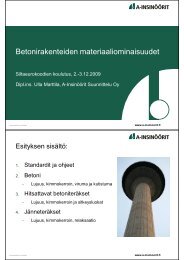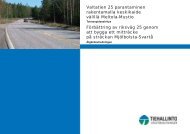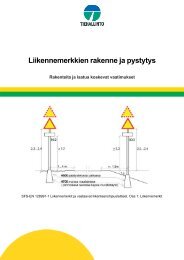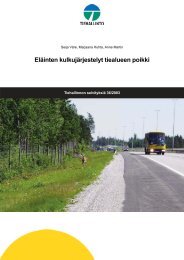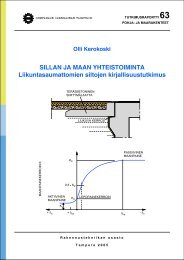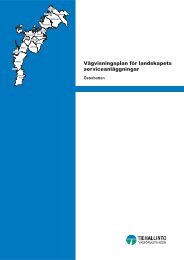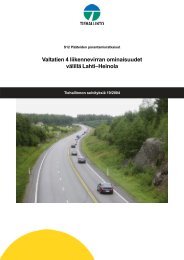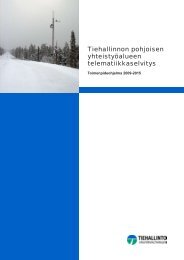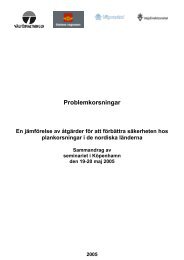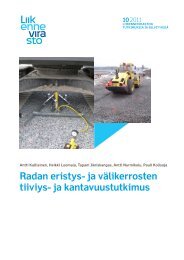Jäänmurtopalvelujen kehittäminen
Jäänmurtopalvelujen kehittäminen
Jäänmurtopalvelujen kehittäminen
You also want an ePaper? Increase the reach of your titles
YUMPU automatically turns print PDFs into web optimized ePapers that Google loves.
for the icebreaking. At the same time it is secured that the VTS personnel<br />
has the competency required by this change in the new role of the<br />
VTS.<br />
3. the Finnish Transport Agency’s management is carrying out a study,<br />
the aim of which is to chart the organisation of traffic management<br />
within shipping, road traffic and on the railways as well as the future<br />
outlook for the functions. In addition, the aim is to evaluate different alternatives<br />
and propose necessary solutions. The focus in this study lies<br />
on the operative activities, especially on the organising. A proposal for<br />
the organising of vessel traffic services is also included in this study.<br />
Icebreaking operations in Sweden<br />
The working group’s last task was to chart the corresponding icebreaking operations<br />
in Sweden as well as give suggestions for possible cooperation and collaboration regarding<br />
the acquisition of icebreaking services.<br />
In the study it was stated that Finland and Sweden have nearly the same icebreaking<br />
needs due to their climatic position. As a result of their long-term cooperation, the<br />
icebreaking measures and the criteria used for these are also very similar. In Sweden<br />
icebreaker assistance is required during mild and normal winters mainly in the Gulf of<br />
Bothnia, the Quark and Bay of Bothnia as well as in the lakes Vänern and Mälaren.<br />
During severe winters icebreaker assistance is required in the Baltic Sea, both on the<br />
east and west coast. The icebreaking season normally starts at the end of November<br />
and continues until the end of May. The aim with the service level is, just like in<br />
Finland, that the average vessel waiting times in icebreaking agreements must not<br />
exceed 4 hours. As for traffic restrictions, the Finnish-Swedish ice classes are used.<br />
As in Finland, icebreaking in Sweden is financed with fairway dues.<br />
Of the icebreakers now operating in Sweden, the Swedish Maritime Administration<br />
owns 5 icebreakers, 4 of which are conventional, with high engine power, and one is<br />
the icebreaker Ale, with low engine power. The Norwegian shipping company B&N Viking<br />
(TransAtlantic AS) owns 3 multipurpose icebreakers of average size. Of the icebreaker<br />
manning, the engine department is usually onboard all year round. During the<br />
icebreaking season additional manning is acquired by buying manning services from<br />
other shipping companies.<br />
The aim with the treaty on icebreaking cooperation, which now only has to be signed,<br />
is to make the icebreaking cooperation more effective, so that the adjacent Finnish<br />
and Swedish sea areas could manage with fewer icebreakers than at present. According<br />
to a study carried out by VTT, efficient cooperation would enable a reduction of<br />
the number of necessary icebreakers in adjacent territorial waters to a total of 1-2.<br />
The treaty would make it possible to get Swedish icebreakers to assist in Finnish waters<br />
during severe winters, in addition to the Finnish icebreakers. During severe winters<br />
Sweden normally needs its own icebreakers to assist the vessel traffic in Swedish<br />
ports, but with efficient cooperation the icebreaking in the Bay of Bothnia could be<br />
managed so that multipurpose icebreakers would not have to be called in until February.<br />
The icebreaking agreement would be made on the basis of the general agreement<br />
separately with each of the service producers involved in the icebreaking.<br />
17



